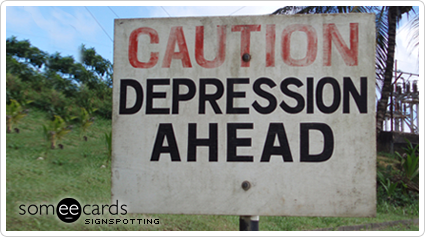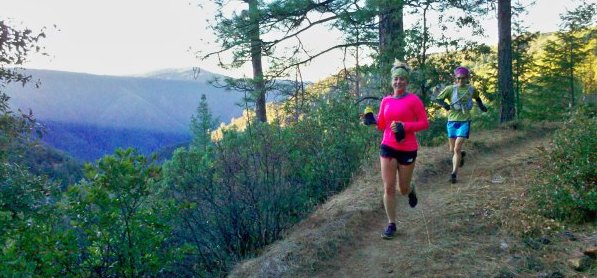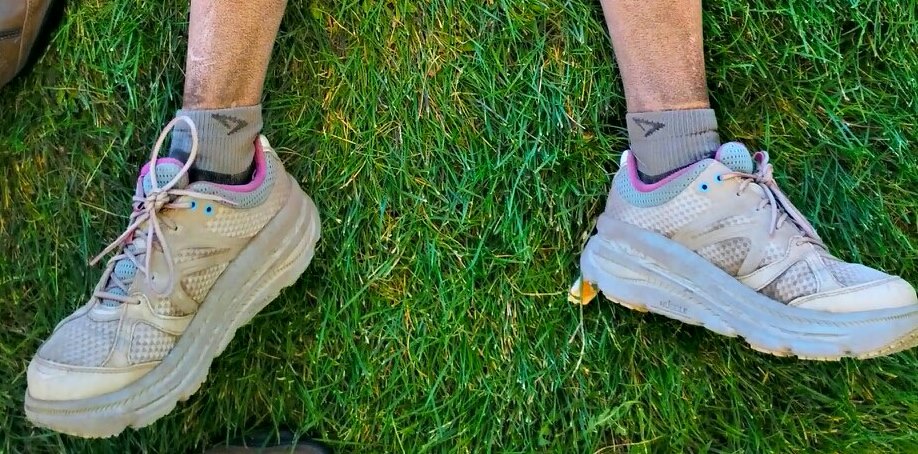Short answer is, well, no one. Not on purpose. But there WAS sand in my eyeballs and I dealt with it and I continued. That’s what running an ultra is often about. Certainly, that’s what the 2017 San Diego 100 was about.
Two things happened in early June. I finished my 9th 100 mile race, and I was infected with Taylor Swift. The latter is a highly-contagious condition, passed through the air in the form of sound waves, affecting those most susceptible: the nervous and tired. And try as you might, it is incredibly difficult to Shake It Off.
It started somewhere in the parking lot in the cool dawn hours before San Diego 100. I heard the chorus of Shake It Off, a song I didn’t previously know that well but now is intimately familiar. Chirping along at 160 beats per minute, nearly the perfect tempo for a jog on the trails (though too low by most exercise physiology standards), and damn if some of the lyrics aren’t good for an ultramarathon kind of mindset. You can’t blame me, can you?
“. . . I keep cruising . . . Can’t stop, won’t stop moving”
But first, how did I get here, to this hamlet of a resort a few hours south of my current home, on this sunny weekend in June? Of course, it started with a little website called Ultrasignup and a credit card. San Diego 100 joined my 2017 race list in January, thanks to a tip-off from a few friends that this historically hot race was actually pretty darn fun and scenic, to boot. This meant I’d be able to focus all of my spring training on bulking up miles and doing heat acclimation, the latter a task I actually rather enjoy. Cycling through the recently-typical but still frustrating loop of train/injury/train/injury, I cancelled a 50K, skipped a long-awaited 110K, and finally toed the line for Leona Divide 50 in April, dropping down to 50K when it was evident that even 50 miles was too much, too soon.
All of these race cancellations and punts put doubts in my mind and a little nagging voice in my head that said, “whoa, there, cowboy”. Who wants long-term injury woes when the evidence points to just taking some REAL healing and rebuilding time? No one . . . except many of we ultrarunners when it comes down to it. You know you shouldn’t eat that extra snack if you’re trying to lose weight, but holy crap is it hard to soldier on when treats are all around us. To ultrarunners, that snack buffet is the massive list of races just waiting for your credit card and itchy typing fingers.
My coach bounced (literally, knowing him) between unbridled enthusiasm/support and cautious warnings to back the heck down. That 110K (Coyote Backbone)? Definitely cancelled. Leona Divide? Not advised, but worked out pretty OK. Jemez 50K in late May, bumped up from the 15 miler? Tentatively accepted. Even the whole shebang of getting to the start line of San Diego? Not adviseable with the extent of my recurring pain patterns. But then again, I’d found from my PT that much of my discomfort was NOT in fact a hamstring injury but rather some extensive referred nerve pain. I didn’t know whether to be estatic or freaked. Nerve issues can be long-lived, but then again so can hamstring complaints. At least I didn’t feel like I was going to be actively risking a muscle tear. THAT made me feel way, way better. Armed with exercises to retrain movement patterns and relieve that nerve, I (ill-advisedly?) decided that running with and through my rehab was an OK proposition.

At Jemez 50K, sailing.
And so, despite any sensible long-range recovery plans, my need to run San Diego persisted and I followed it right to that starting line at 6 a.m. on June 9th. We set out slowly down singletrack. Actually really slowly, like walking a lot of the first mile, chuckling as we came crashing to a single-file halt from each brief jog. It was necessary through the swampy meadow, the path set through the grass and cold misty air. That cold was almost painful now but we knew we’d love to have it in about 8 hours.
A bit about San Diego 100’s weather: this is known as a hot, hot race. Want to run ‘downhill’ in the heat? You do Western. Want to run in the mountains in the heat? You do Angeles Crest. But in the last decade, the appeal of running moderately tough trails in the heat has brought a lot of talent to San Diego, making it well known as a sleeper tough 100. I prepped for heat for months; it’s what any pragmatic runner should do. Actually, I’d make a case for doing heat training in late spring to ALL ultrarunners, just because it better prepares you for any heat you encounter, and makes you a more efficient sweating machine in all temperatures, too.
All that in mind, I had no fear about heat. I knew to drink more than I want to (already being one of those low-drinker types), and to just not push the effort level under the mid-day sun. We ambled along out of the meadow and up a good fire road climb with ample rocks. I chugged along and said hi to a few known faces (hi, Summer! hi, Robert!) until we crested the climb and started down a fairly nasty Zane Grey-ish trail. The moniker of “sneaky hard” 100 owes some of its reason to ample sections with bad footing. If some runners find their weakness in long or steep climbs, I find it in technical terrain. I can grind out the worst longest steepest uphills and leave some folks in the dust, but throw me on a flat trail strewn with rocks and everything balances out. That’s a long way of saying that quite a few people passed me here, and that it’s not a concern. Some of them I’ll pick off on climbs later, some of them I’ll pick off in the last 30 miles, and some of them I’ll never see again. I’ll run my race and try to have a good day while finishing strong.
As the sun inched upward, any full blast of rays was just a teaser for how quickly the thinner air at a mile high can transfer heat to our skin. A dry breeze came and went, along with preemptive advice from early aid station volunteers to “drink up, drink a lot—that wind will dry you right out!” We passed through mile 8 aid, mile 12 on a friendly little out and back where I spotted more friends like Constance Wannamaker and Amy Chavez, two ladies I knew would do well and I’d likely not pass them later on unless they bonked hard *and* I had a phenomenal race. (They didn’t, and I didn’t.) Onward to the first major stop with drop bags and crew at mile 21. This would be mile 91 on the way back, and boy did that ever feel like a LONG way away at 11 a.m. with the temperatures rising. My crew and able photographer Geoff Cordner refilled bottles, fetched snacks, and sent me on my way to the next stop at 28. I made a note to really try to get through aid stations quickly as they can be quite a time-sink.
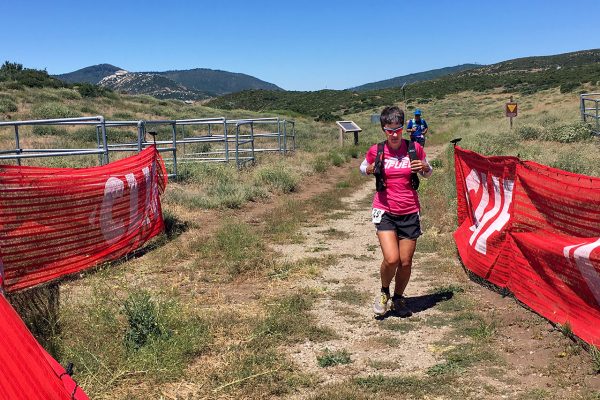
Mile 21, stripping down to refill.
“…I’m dancing on my own; make the moves up as I go…”
Today—like usual—there is nervous and friendly chatter in the early miles, but my threshold for engaging in conversation varies widely. Some moments I’m the chatty one, other times I just grunt when someone is more chipper than I have bandwidth for. Today I wanted to say hi to a few known friends, and have a few quick meet & greets with new faces. After that, I’m usually good for the next 24+ hours of near solitude. Running solo is my preferred way to train, giving my brain the space to just wander. Oh, and music? Not my gig, either.
I talked a little with a guy from Ventura named Mallory nicknamed Mooey (Mooie?) (http://www.ultralive.net/sd100#tracking/runner/107) wearing RaceReady shorts. I complimented him on his old-school style, but he’d just bought them recently on a running store recommendation. That company was pretty much the only game in pocketed-shorts-town back in 1999-ish (check out this chafing discussion in 2001 and this gear summary from 2002). These days, I’m more of a better-than-naked fan, but hey, those mesh-pocketed pioneers carried my gels through a few ultras back in the day. Glad to hear the company is actually still around.
As the heat rose, I felt pretty good, all things considered. I was taking it at a medium-effort, staying near many of the same faces at least for now. Miles 30-45 can be the crux of this race: hot, with a pavement section that can destroy some knees, followed by an uphill trail slog with the sun directly on you as you clamber over technical terrain. This is Noble Canyon. It is 3pm and yes, it is toasty. But actually, it’s not *that* toasty. We are surely lucky, for now. Last year’s high was about 108. This year will barely crack the 90s.
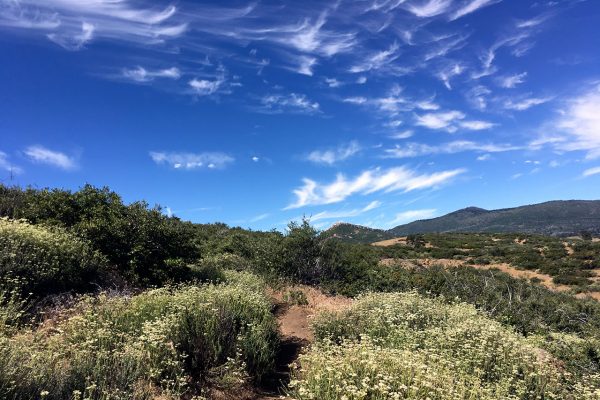
Nothing beats desert clouds, really.
Since San Diego almost fables itself as a scorcher, I had a vision of Race Director Scotty Mills seeing the mild forecast and then placing an Amazon Prime order for hundreds of cordless hair dryers, one for every runner to make up for the missing heat. Ultimately, the race had one of its mildest years on record, but that doesn’t mean we had pleasant temperatures. And boy was that wind dry, sucking the moisture out like a straw. I still saw serious ashen faces at aid stations and saw one guy step off the trail to launch his lunch. In the end, the race probably went through hundreds of pounds of ice instead of thousands.
The weather bonus was yet to come: we were about to be delivered a very different “treat” out there after dark, out in the moonlight. Don’t worry, we’ll get there.
I chatted a bit with a guy from somewhere near Redlands about his first 100 miler (this one). He was a little worried about what would happen after 12 hours, as he’d never gone that far before. He worried about lack of sleep and hallucinations but at least I reassured him they’re not crazy or trippy like pink elephants and stuff. I hope. My experience has been more like this: hey, an SUV parked near the trail, nope, that’s a rock; whoa, a big tent next to the trail, nope, that’s a rock; why is there a house out here right on the trail? nope, that’s a big rock; are those folding chairs sitting next to the trail? nope, that’s a tree. And on, and on. Mundane but out of place things is my style of visual fuckery. I would have a much harder time with night running if my hallucinations were actually scary. Now let’s hope I didn’t jinx everything forever.
Speaking of night, here it comes. The day’s heat dissipating, I roll into the 48 mile aid station just after dark, more or less on schedule. I’m not as fast in the dark (who is, really?), so this next stretch might take a little extra effort to keep things moving. It’s 7 more miles before our big honkin’ out and back downhill to the turnaround point at mile 64. I know, 64 miles is the turnaround? Hang tight.
Here’s the general layout of the course: picture one long out and back with a little loop at the beginning and a bulge in the middle where the trail diverges. Like a snake with a huge head and a gopher in its belly, and we’re going to follow the outline of the snake body. We do the loop (8 miles), then go down the first stretch of trail for about 20 miles; we’ll come back on this later. Then the trail splits and we go one way for about 25 miles, then join the snake tail for a 14 mile out and back, then come back up a different and shorter split of the trail for 20 miles, then join up again for the last 9 miles. Confusing? Yeah, I get it. Take a peek at the map on my Strava file: https://www.strava.com/activities/1032406160/overview
“…I don’t miss a beat; I’m lightning on my feet…”
Remember how we we dodged a bullet with the “pretty warm” temperatures instead of “scorching hot”? Here’s where things got interesting. Just when the moon was rising full and buttery over the PCT on that 7 mile downhill, it came: 50mph sandblaster dermabrasion treatments. A moonlight spa right there on the PCT, yeah, that’s what it was. I bet some destination resorts charge for this kind of torture just to tighten up the pores, or something. What it did for us was tighten up our jackets, and made me wish I still had my sunglasses to protect my eyeballs from dust. I’d turn my light up full blast to make up for the glasses and just get on with it. One switchback with blinding gusts, kind of sort of running, then the next with a tailwind so strong it was chilly without gloves. Repeat . . . until you almost can’t take it anymore, and then it’s another half mile to the aid station. I saw Constance on this stretch, headed back uphill and chilled without a jacket due to a mixup with drop-bags. Boy did I wish I had gloves to give to her since she does NOT have fun when it’s cold.
Eventual winner Kris Brown’s race report summed it up well, “A beautiful and serene day turned into a chaotic and violent night, but by then I was engaged.” I was engaged, too. Focused on getting the heck down that trail so I could go back up and get OUT. So here’s the thing: I passed about 15 people on this stretch. That’s where I can do alright at these things: when the going gets obnoxious, I can soldier on better than most. When folks around me are having the shit annoyed out of them, I see that and I get just a little stronger, seeing their trepidation. A fondly remembered high school XC teammate used to make us both chant as we strode upward, “I love hills! I love hills!” Everyone else’s bummer was our chance. Thanks, Robin.
“…I stay out too late; got nothing in my brain…”
I leapfrogged at least a few down at the aid station, and then trudge/jogged back up the trail. I passed a few more here, and started getting into my later-race groove: count the people you pass, try not to let any/many pass back. Repeat until finish line. These solitary miles were what I came here for: all static in my brain slows, all planning and worrying and scheming dissipates. During ultras I don’t have big brainstorms and new ideas, but I don’t have much of anything else that clogs my neurons, either. I just GO. Sometimes that’s all I can think about and it is a relief to the psyche.
As the night got deeper and we left the climb for more mild trail, I tried to reel more folks in but it was getting harder with how spread out we were. So I just went down into my cave and just tried to move as efficiently as possible when your feet hurt, you ass hurts, your actual ass hurts, and you could do with a little nappy right about now. Coffee instead? Yes, indeed! Leaving the 3:30am aid station with a jolt was just what I needed to get on with getting to my pacer at mile 84.
Only 5 more miles to the next aid, my drop bag, new socks and shoes, and a place to ditch my lights as soon it will finally get a wee bit light. But first, more miles in the dark, more gusty winds and sand blasting, and a bit of a slowdown in my pace. This is one of my slowest sections, despite the coffee. Just before dawn is often sleepiest, tiredest, and so on. Most runners have pacers through here (though San Diego is set up *perfectly* for solo runners and awards them accordingly with a different buckle), but mine will join me for the last several hours. This is a choice I make often, to run without a pacer or with one only for a short key section, or only if they want to join me. Just another introvert thing, probably.
At mile 80 the aid station is here and the light is indeed coming, so I ditch the headlamp and handheld and sit down to swap out shoes, but realize with my feet already swollen my new pair are just not going to cut it. So, I wipe my feet down and change socks only, which feels at really good. It turns out (after later inspection) that one of my socks had worn a big hole right in the heel over those 80 sandy miles. That could have been just one more of the sources of foot discomfort. Ok, get the heck out of here; I’ve already blown at least 10 minutes doing this swap out.
Despite the dawn, the winds do not abate and in fact become a bit stronger on this stretch, nearly picking me up on a few switchbacks over this open terrain. It’s an incredibly scenic section but difficult to enjoy with sand in my eyes. I picked up a few things on the trail that must have been dropped or blown off their runners, to hand off at the next aid station. I wonder how many things were blown off that didn’t land on the trail but are far, far away…. I’m a little hungry but not feeling the food situation. This leaves me low, mentally. A little sad, a little melancholy.
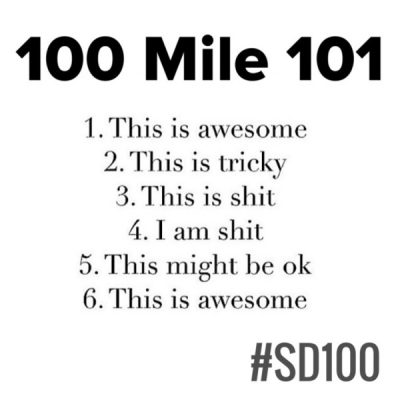
Actually, repeat #3-#5 for hours as necessary.
Mile 84 arrives and with it another drop bag full of gels (VFUEL gets my vote for the last year+) and one more pack of chews for extra salt and, well, just something to chew on. I’d exhausted my ginger chews already. This aid station and last actually had salty rice balls so I ate ate least one of those on my way out. They are hard to chew and move, but seem to deliver good calories. Must experiment more with this, as I don’t eat enough in these races to, well, race.
My crew/pacer/cattle-prod Geoff and I set out, now making better time because I still think I can crack 30 if I don’t majorly mess up. Earlier one of the pie-in-sky goals was 27, but I knew that would be a stretch. So I marked out the splits for 28, 30, and “finish” to be prepared. Mostly I’d been hitting the 30 hour splits but was behind those by 30 minutes right now. It is hard to apply last year’s results to this year as the heat was awful then, but it’s all I had. I know I am relatively strong at the end compared to most folks, so I can usually beat late-race projections, so off we went.
I was in a mental low point a few spots here, needing to run, wanting to run, but not actually getting the mojo. I felt a bit queasy, even a little dizzy for a spell, but realized that was because my stomach was completely empty. So it wasn’t bad food nausea, but rather NO food. This is actually a common problem for me: I get behind on calories not for lack of appetite but just because I don’t accurately refeed at the level I require. Sometimes I think I eat enough by grazing at the aid station but usually it’s far from the target. This is still something I am working out in order to be able to RACE ultras rather than just complete them.
So we ran, sometimes slowly but what I could muster.
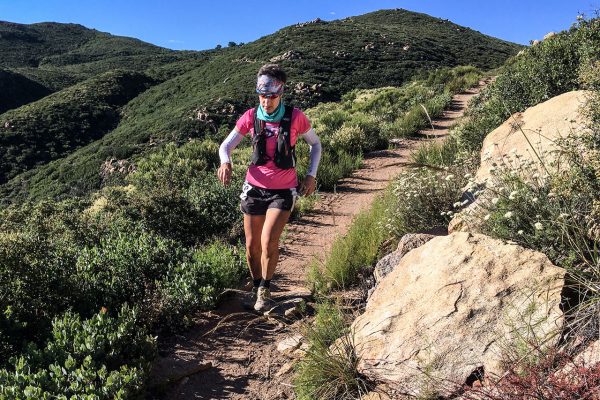
And I walked, sometimes crabby and morose.
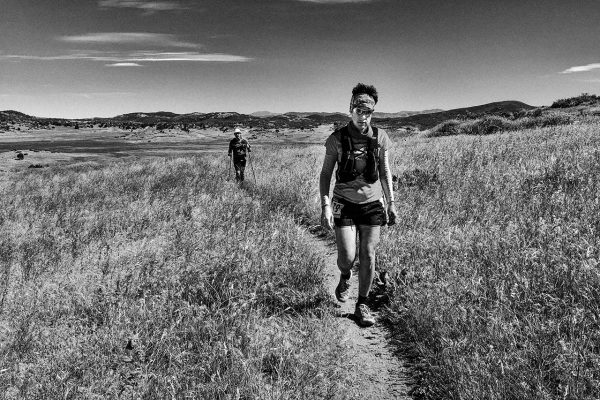
I was told at one point that my pace was falling off and that almost made me burst into tears. Not at the concept of missing any time goal, but because I felt like I was being scolded. Low points in an ultra must be like being a toddler again. No cookie? Wahhhhh! This is what having everything magnified feels like. Honestly, the emotional ups and downs that we 100 mile runners feel should go a long way to helping dudes understand, just a little, what PMS is like, when these moods and emotions just seem to come out of nowhere. How ya like that now, boys? Super-fun, ain’t it? But the key in both situations is this: know that it is normal, and wait it out.
Math in my head showed me that going sub-30 was a sure thing, and now it was just a matter of by how far. So we ran. I passed a few more folks but everyone was moving pretty well so staying in front of them was work. That made me happy: I was surrounded by runners like me, strong at the end. One quick pitstop and I lost another place, but it was totally necessary. The end of Wasatch in 2014 was nearly catastrophic, so I hoped to not repeat that situation.
We rounded the lake, and saw a finishing chute, all uphill, and I had to run it. No walking at this point, no way. Not like my jog was anything resembling a kick, but walking across a finish line just doesn’t compute. And then, it was done.
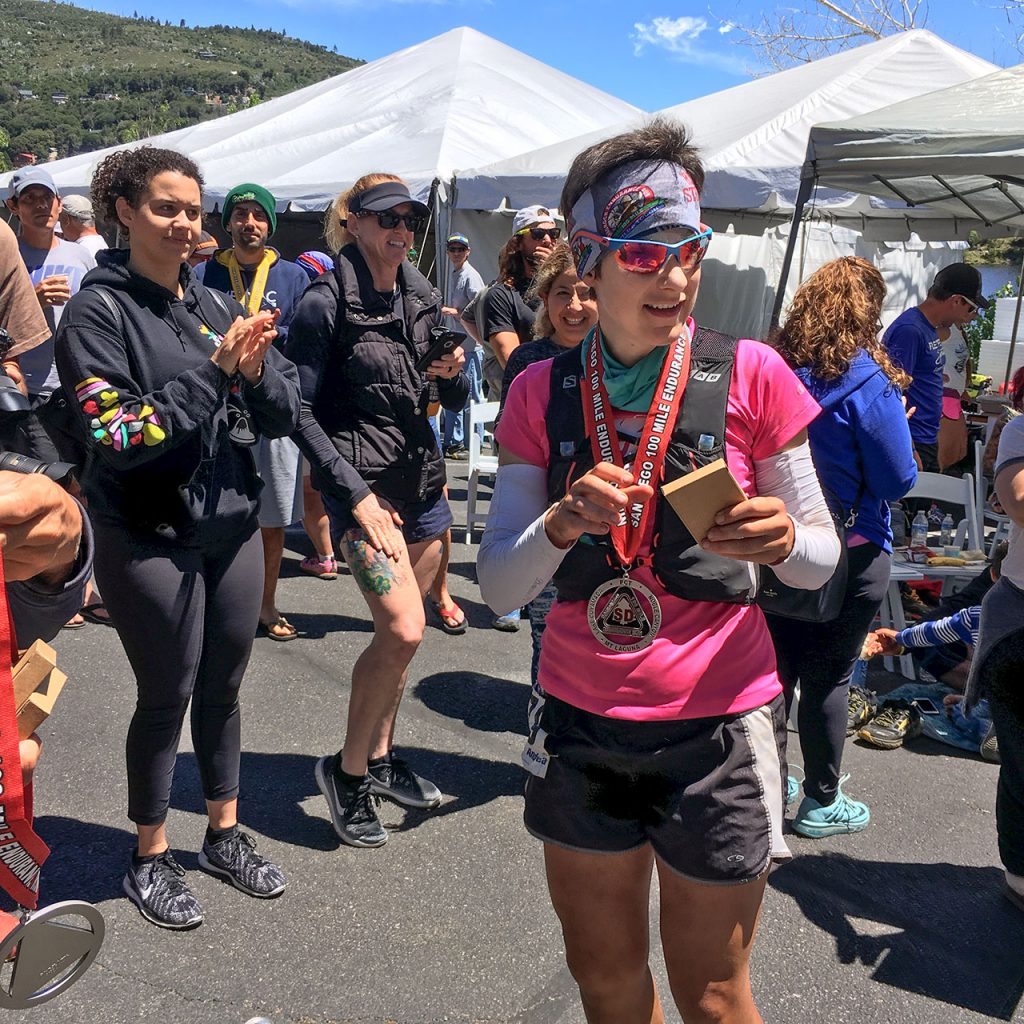
Aftermath and notes for future injury assessments: my ass hurt in several ways, only one of which was a deep aching at the inside hamstring attachment (not the priformis, that one I know well). But with that pain now gone I am not worrying about it. Some outside knee pain, the same kind as over the last month. Receded after 10 miles never to return. Hip/groin flexor pain: a little and manageable. Painkillers: 6-ish ibuprofens, plus 10 of these buggers after learning about them on a physio podcast: Meriva Curcumin. Can’t hurt, and maybe they helped even more than I realized.
That song? Yeah, it was in my head throughout the race without me even knowing all the verses. It’s actually not a terrible little pop song. Now, of course, I know it well, and now I can infect you, bwahahaha: Taylor Swift’s Shake it Off.
The gear:
- Salomon Sense Ultra 3 pack (a little too big even in size S, but otherwise very comfy)
- Salomon old style soft flasks – the new ones with the firm bottom hurt my ribs.
- Target C9 Champion shorts circa about 2011: the only shorts that NEVER chafe me; this black pair have been with me on at least 4x 100s start to finish.
- VFUEL shirt: nothing special about the shirt, just what it represents as my first ever ambassadorship in ultrarunning. Curious about VFuel? Give it a go with 20% off: use the code ANDREA20%
- Julbo photochromatic shades: darker in sun and lighter in shade. I could have used these overnight against that wind!
- HOKA ONE ONE Speed Instinct shoes: just a tiny bit too “light” for a 100? But really nice wide toebox and good but not aggressive tread. A thin rock plate would make these perfect.
- Smartwool socks: super comfy but prone to getting holes when abraded
- The food:
- VFuel: about 15 gels in all flavors, plus Ginger Twist drink taken double-strength. I might lobby VFuel for chews, too, with the same flavors as their drinks. Or, maybe… maple bacon WAFFLE! Waffles are huge right now. Hint, hint.
- Waffles: 3 GU gluten-free waffles. I like these except that they are too sweet. A little more savory, guys?
- Chews: Clif chews mostly in margarita flavor for the salt.
- Aid station food: not a heck of a lot. 2 rice balls, a handful of m&ms, a few pieces of potato.
- Total estimated calories: 2500-3000? Not terrible if I were a better fat burner. Not enough for a carb burner.
I almost feel bad that I wiped off my feet at mile 80, which ruined the awesomely black coating of grime on them for this post-mortem photo op. My leg “tights” are still pretty impressive, though.
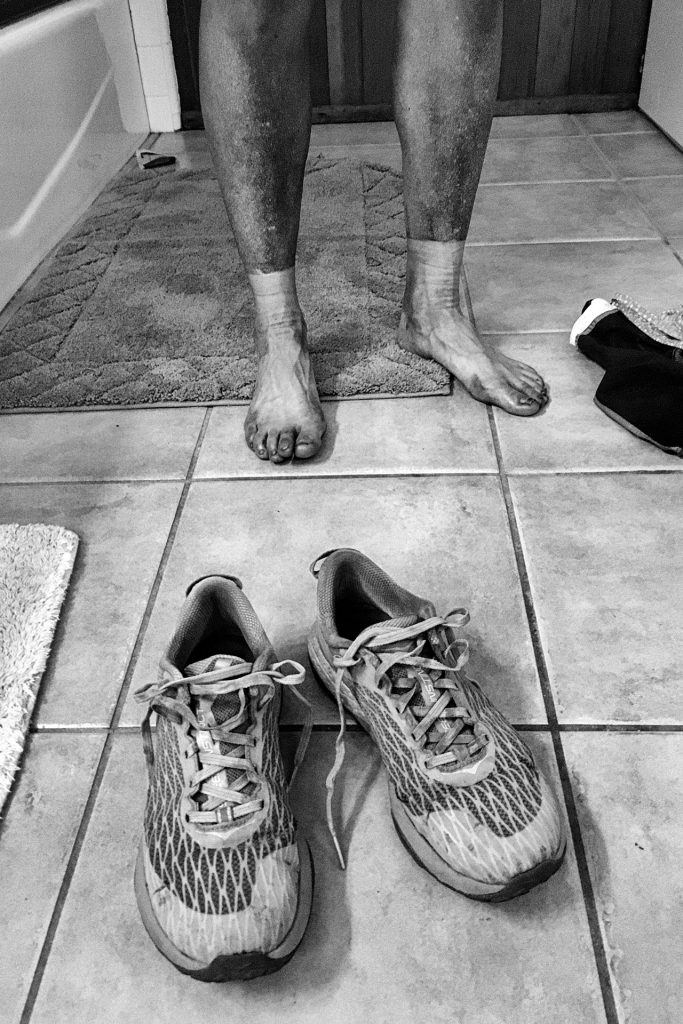
Like my tights?

















